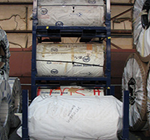Ensuring OSHA Compliance with Portable Storage Solutions
In any workplace, ensuring the safety and well-being of employees is of paramount importance. This is where OSHA (Occupational Safety and Health Administration) compliance plays a crucial role. OSHA is a federal agency in the United States dedicated to establishing and enforcing safety standards to protect workers from workplace hazards. Complying with OSHA regulations is not only a legal requirement but also a fundamental responsibility for employers. It goes beyond mere adherence to rules; OSHA compliance fosters a culture of safety, instills trust among employees and contributes to the overall success and reputation of the organization.

Portable storage solutions refer to the use of containers or units that can be easily transported and deployed at different locations, offering a convenient and flexible storage option. In industries such as construction, manufacturing, retail and logistics, portable storage solutions play a vital role in addressing storage challenges. They provide temporary or permanent storage for equipment, tools, raw materials, inventory and other goods, streamlining operations and optimizing available space.
OSHA Standards for Storage and Material Handling
OSHA sets forth comprehensive standards to ensure the safe handling and storage of materials in the workplace. These standards are designed to protect employees from potential hazards associated with improper storage practices. It also cover various aspects of material handling, including storage equipment, storage areas and safe stacking procedures. Compliance with these standards is crucial to minimize the risk of accidents, injuries and property damage, promoting a safe & secure work environment.
Common Violations and Penalties
Failure to comply with OSHA regulations regarding storage solutions can result in serious consequences for employers. Common violations include overloading containers beyond their capacity, improper storage of hazardous materials and neglecting to provide adequate ventilation.
Penalties for non-compliance with OSHA standards can vary based on the severity of the violation. These penalties may include monetary fines and, in extreme cases, shutdown orders until corrective actions are taken. Repeat violations or egregious offenses may result in higher fines and increased scrutiny from OSHA inspectors.
Features to Look for in OSHA-Compliant Portable Storage Solutions
Sturdiness and Durability: OSHA-compliant portable storage containers should be built to withstand the rigors of the workplace environment. Look for units made from high-quality materials such as heavy-duty steel or impact-resistant plastic. Sturdy construction ensures that the storage solutions can endure the demands of industrial settings, including exposure to heavy loads, rough handling and environmental factors.
Locking Mechanisms and Security Features: Ensuring proper control of access is crucial for OSHA compliance. Look for portable storage containers equipped with secure locking mechanisms to prevent unauthorized handling of materials. Locks can deter theft, prevent tampering with hazardous substances, and maintain the integrity of stored items, promoting a safe and controlled environment.
Ventilation Options: For hazardous materials and chemical storage, ventilation is essential to manage potential risks. OSHA-compliant portable storage solutions should offer proper ventilation options to reduce the buildup of vapors, fumes, or gases that could pose health hazards to employees. Adequate ventilation helps maintain air quality and ensures compliance with safety regulations.
Importance of Employee Training on OSHA Compliance
Employee training is a critical aspect of ensuring workplace safety and OSHA compliance. Training employees on OSHA regulations related to custom metal containers helps create awareness about potential hazards and safe handling practices. It empowers workers to recognize and mitigate risks associated with storing materials, promoting a safer work environment and reducing the likelihood of accidents or injuries.
Training Program for Workers Handling Portable Storage
To maximize the effectiveness of training, organizations should develop a comprehensive program tailored to the specific needs of workers handling portable storage. The program should cover essential topics such as proper storage procedures, safe handling techniques, understanding OSHA regulations, emergency response protocols and the correct use of personal protective equipment (PPE). By providing relevant and job-specific training, employees will gain the knowledge and skills needed to handle portable storage units safely and in compliance with OSHA standards.
Regular Safety Reviews and Refresher Training Sessions
Workplace safety is an ongoing commitment, and regular safety reviews are essential to maintain a safe environment. Organizations should conduct periodic safety reviews to assess the effectiveness of the training program, identify areas for improvement and ensure compliance with OSHA guidelines. Additionally, scheduling refresher training sessions at appropriate intervals helps reinforce safe practices, updates employees on any changes in regulations or procedures, and reminds them of potential hazards.
By investing in OSHA-compliant portable storage solutions, businesses can create a secure and compliant work environment that safeguards their most valuable asset: their employees. By implementing robust portable storage containers with features that meet OSHA requirements, companies enhance workplace safety, reduce the likelihood of accidents, and avoid costly penalties associated with non-compliance. Ultimately, the commitment to OSHA compliance not only protects employees but also promotes a safety-first culture that fosters productivity, enhances employee morale and ensures long-term success for the organization.
About The Author










